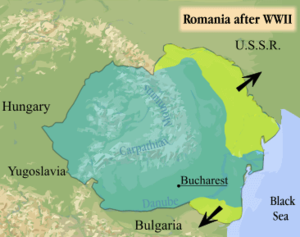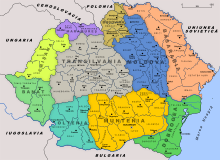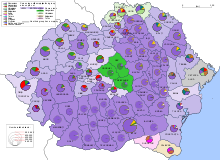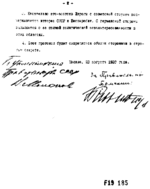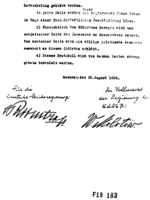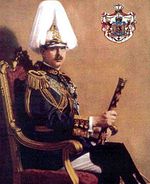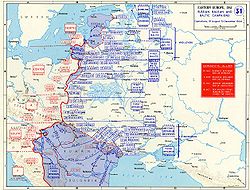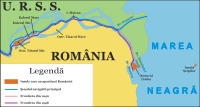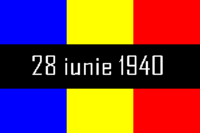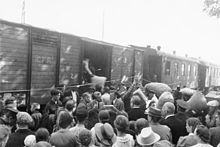- Soviet occupation of Bessarabia and Northern Bukovina
-
History of Moldova 
This article is part of a seriesAntiquity Chernyakhov culture Dacia, Free Dacians Bastarnae Early Middle Ages Origin of the Romanians Tivertsi Brodnici Golden Horde Principality of Moldavia Foundation Stephen the Great Early Modern Era Phanariots United Principalities Bessarabia Governorate Treaty of Bucharest Moldavian Democratic Republic Sfatul Ţării Greater Romania Union of Bessarabia with Romania The Holocaust in Romanian-controlled territories Moldavian ASSR Moldovenism Moldavian SSR Soviet occupation of Bessarabia and Northern Bukovina Soviet deportations Republic of Moldova Independence of Moldova War of Transnistria History of independent Moldova
Moldova Portal
During June 28 - July 4, 1940, the Soviet Red Army military occupied[1][2][3] the formerly Romanian held regions of Bessarabia, Northern Bukovina, and Hertsa, after the Romanian government agreed to evacuate its troops and administration.
The Soviet Union had planned to accomplish the annexation with a full-scale invasion, but the Romanian government, under a Soviet ultimatum delivered on June 26, agreed to withdraw from the territories in order to avoid a military conflict. Germany, who had acknowledged the Soviet interest in Bessarabia in a secret protocol to the 1939 Molotov-Ribbentrop Pact, had been made aware prior of the planned ultimatum on June 24, but had not informed the Romanian authorities, nor was willing to provide support.[4] The Fall of France on 22 June is considered an important factor in the Soviet decision to issue the ultimatums.[5]
On August 2, 1940, the Moldavian Soviet Socialist Republic was proclaimed as a constituent republic of the Soviet Union, encompassing most of Soviet-controlled Bessarabia, as well as the former Moldavian Autonomous Soviet Socialist Republic on the left bank of the Dniester. The regions inhabited by Slavic majorities (Northern Bukovina, the region of Khotin and Southern Bessarabia) were included in the Ukrainian SSR. The Soviet administration was marked by a series of campaigns of political persecution, including arrests, deportations to labour camps and executions.
In July 1941, Romanian and Nazi German troops recaptured Bessarabia during the Axis invasion of the Soviet Union. A military administration was established and the region's Jewish population was either executed on the spot or deported to Transnistria, where further were killed. In August 1944, during the Soviet Jassy-Kishinev Offensive, the Axis war effort on the Eastern Front collapsed, and Soviet forces entered not only Bessarabia, but also occupied most of Romania.[6] On September 12, 1944, Romania signed the Moscow Armistice with the Allies. The Armistice, as well as the subsequent peace treaty of 1947, confirmed the Soviet-Romanian border as it was on January 1, 1941.[7][8]
Bessarabia and Northern Bukovina remained part of the Soviet Union until its dissolution in 1991, when they became part of the newly independent states of Moldova and Ukraine. In its declaration of independence of August 27, 1991, the government of Moldova condemned the creation of Moldavian SSR, declaring that it was done in the absence of any real legal basis.[9]
Historical background
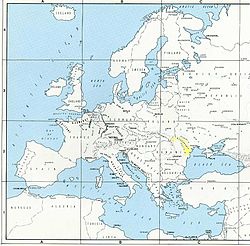 Europe at the signing of the Molotov-Ribbentrop Pact, with Bessarabia and northern Bukovina in yellow.
Europe at the signing of the Molotov-Ribbentrop Pact, with Bessarabia and northern Bukovina in yellow.
Soviet-Romanian relations
During the 1917 Russian Revolution, a National Council was formed in Bessarabia, at the time part of the Russian Empire, to manage the province in the new political situation.[10] The council, known locally as Sfatul Ţării, initiated several national and social reforms, and on December 2/15 1917 declared Bessarabia an autonomous republic within the Russian Federative Democratic Republic.[11][12] A rival council loyal to the Petrograd Soviet, the Rumcherod, was also formed and by late December the latter gained control over the capital, Chişinău, and proclaimed itself the sole authority over Bessarabia.[13][14] With the consent of the Entente, and, according to the Romanian historiography, on the request of Sfatul Ţării, the Romanian troops entered Bessarabia in early January, and by February had pushed the Soviets over the Dniester.[15][16] Despite later declarations by the Romanian prime-minster that the military occupation was made with the consent of the Bessarabian government,[17] the intervention was met with protest by the locals, notably by Ion Inculeţ, president of Sfatul Ţării, and Pantelimon Erhan, head of the provisional Moldavian executive.[18] The executive even authorised the badly-organised Moldavian militia to resist the Romanian advance, although with little success.[19] In the wake of the intervention, Soviet Russia broke diplomatic relation with Romania and confiscated the Romanian Treasure, at the time in Moscow for safekeeping.[20] To calm the situation, the Entente representatives in Iaşi issued a guarantee that the presence of the Romanian Army was only a temporary military measure for the stabilisation of the front, without further effects on the political life of the region.[21] In January 1918, Ukraine declared independence from Russia, leaving Bessarabia physically isolated from the Petrograd government, and leading to the declaration of independence of the Moldavian Republic on January 24/February 5.[22] Some historians consider that the declaration was made under Romanian pressure.[23] Following several Soviet protests, on February 20/March 5, the Romanian prime-minister, General Alexandru Averescu, signed a treaty with Soviet representative in Odessa, Christian Rakovsky, which provided that Romanian troops be evacuated from Bessarabia in the following two months in exchange for the repatriation of Romanian POWs held by the Rumcherod.[24] After the White Army forced the Soviets to withdraw from Odessa, and the German Empire agreed to the Romanian annexation of Bessarabia in a secret agreement part of the Buftea Peace Treaty on March 5/18,[25][26] the Romanian diplomacy repudiated the treaty, claiming the Soviets were unable to fulfil their obligations.[27] On March 27/April 9 1918, Sfatul Ţării voted for the union of Bessarabia with Romania, conditional upon the fulfilment of the agrarian reform. The vote is regarded as controversial by several historians, including Romanian ones such as Cristina Petrescu and Sorin Alexandrescu.[28] According to US historian Charles King, with Romanian troops already in Chişinău, Romanian planes circling above the meeting hall, and the Romanian prime minister waiting in the foyer, many minority deputies chose simply not to vote.[29] On April 18 Georgy Chicherin, the Soviet Commissar for Foreign Affairs, sent a note of protest against the incorporation of Bessarabia into Romania.[30]
In August 1916, the Entente and neutral Romania signed a secret Convention that stipulated Romania will join the war against the Central Powers in exchange for several territories of Austria-Hungary, among them, Bukovina.[31] During the last part of World War I national movements of the Romanians and the Ukrainians began to emerge in the province, however the two movements had conflicting aims, each seeking to unite the province with their national state.[32] Thus, on October 25 1918, a Ukrainian National Committee, gaining the upper hand in Czernowitz, declared Northern Bukovina, populated by a Ukrainian majority, part of the West Ukrainian People's Republic.[33] On October 27 the Romanians followed suit, proclaiming the whole region united with Romania,[34] and calling in the Romanian troops.[35] The Romanian intervention quickly established the Romanian Assembly as the dominant force, and on November 28 a Congress of the Romanians, Germans and Poles voted to unite with Romania. The representatives of the Ukrainian and Jewish population boycotted the Congress, and the struggle between ethnic factions continued for several months.[36]
During the Russian civil war, the Soviet governments of Ukraine and Russia, prompted by the unrest in Bessarabia due to Romanian occupation, issued a joint ultimatum to Romania on May 1, 1919, demanding its withdrawal from Bessarabia, and the next day, Christian Rakovsky, the Chairman of the Ukrainian Soviet government, issued another ultimatum demanding the withdrawal of Romanian troops from Bukovina as well. The Red Army pushed the Romanians over the Dniester, and even managed to land a detachment on the right shore, and a Besarabian Soviet Republic was proclaimed. The ultimatum also came in the context of the Hungarian Revolution, Soviets hoping to prevent a Romanian intervention in Hungary. A large scale rebellion in Ukraine prevented further Soviet advance.[37][38][39] Soviet Russia and later the Soviet Union would continue their policy of non-recognition of Romanian sovereignty over Bessarabia, which they considered Romanian-occupied territory, until the 1940 events.
During the negotiations pre-dating the Treaty of Paris, the US representative asked for a plebiscite to be hold in Bessarabia to decide it's future, however the proposal was obstinately refused by the head of the Romanian delegation, Ion I. C. Brătianu, claiming such an undertaking would allow the distribution of Bolshevik propaganda in Bessarabia and Romania.[40] A plebiscite was also requested at the Peace Conference by the White Russians, only to be rejected again.[41] The Soviets would continue to press for a plebiscite during the following decade, only to be dismissed every time by the Romanian government.[42]
Romanian sovereignty over Bessarabia was de jure recognized by the United Kingdom, France, Italy, and Japan by signing a Bessarabian Treaty on October 28, 1920. Soviet Russia and Ukraine promptly notified Romania that they didn't recognize the treaty's validity, and didn't consider themselves bound by it.[43] Ultimately, Japan failed to ratify the treaty, and this never came into force,[44] leaving Romania without a valid international act to justify its possession of Bessarabia.[45] The United States refused to discuss territorial changes in the former Russian Empire without the participation of a Russian government.[46] Thus it declined to recognize the incorporation of Bessarabia into Romania, and, unlike its position of recognizing of the independence of the Baltic States, it insisted that Bessarabia was a territory under Romanian military occupation, and incorporated the Bessarabian emigration quota into the Russian one in 1923.[47] In 1933, the US government tacitly included the Bessarabian emigration quota into the Romania, an act considered a de facto recognition by the Romanian diplomacy.[48] However, during World War II, the US argued it had never recognized Bessarabia's union with Romania.[49]
In 1924, after the failure of the Tatarbunar Uprising, the Soviet government created a Moldavian Autonomous Soviet Socialist Republic on the left bank of the Dniester river within the Ukrainian SSR. Romanian government saw this as a threat, a possible staging ground for a Communist invasion of Romania. Throughout the 1920s, Romania considered itself a pillar in the cordon sanitaire policy of containment of the Bolshevik threat, and avoided direct relations with the Soviet Union.[citation needed]
On August 27, 1928, both Romania and the Soviet Union signed and ratified the Kellogg-Briand Pact, renouncing war as an instrument of national policy.[50] As a follow-on to its adoption, the Soviet Union signed a protocol confirming adherence to the terms of the Pact with its western neighbors: Estonia, Latvia, Poland, and Romania on February 9, 1929.[51] In signing the Pact, the contracting parties agreed to condemn war as a recourse to solving conflict, to renounce it as an instrument of policy, and that all conflicts and disputes are to be settled only by peaceful means.[52] On the occasion, Soviet ambassador Maxim Litvinov made it clear that neither the pact nor the protocol meant renunciation of Soviet rights over the "territories occupied by Romanians".[53] On July 3, 1933, amongst others, Romania and the Soviet Union signed the London Convention for the Definition of Aggression, Article II of which defines several forms of aggression: "There shall be recognized as an aggressor that State which shall be the first to have committed one of the following actions: First—a declaration of war on another State. Second—invasion by armed forces of the territory of another State even without a declaration of war. (...)" and "No political, military, economic or other considerations may serve as an excuse or justification for the aggression referred to in Article II."
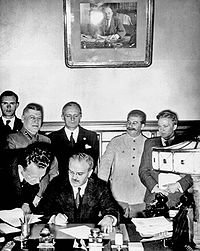 Soviet Foreign Minister Vyacheslav Molotov signs the Molotov-Ribbentrop Pact. Behind him stand (left) German Foreign Minister Joachim von Ribbentrop and (right) Soviet leader Joseph Stalin.
Soviet Foreign Minister Vyacheslav Molotov signs the Molotov-Ribbentrop Pact. Behind him stand (left) German Foreign Minister Joachim von Ribbentrop and (right) Soviet leader Joseph Stalin.
In January 1932 in Riga, and in September 1932 in Geneva, Soviet-Romanian negotiations were held for a non-aggression treaty, and on June 9, 1934, diplomatic relations were established between the two countries. On July 21, 1936, Maxim Litvinov and Nicolae Titulescu, the Soviet and Romanian Ministers of Foreign Affairs, agreed upon a draft of a Mutual Assistance Pact.[54] It was sometimes interpreted as a non-aggression treaty, that would de facto recognize the existing Soviet-Romanian border. The protocol stipulated that any common Romanian-Soviet action should be pre-approved by France. In negotiating with the Soviets for this agreement, Titulescu was highly criticized by the Romanian far right. The protocol was to be signed in September 1936. However, Titulescu was dismissed in August 1936, leading the Soviet side to declare the previously achieved agreement null and void. No attempts at political rapprochement between Romania and the Soviet Union have been undertaken since then.[55] Moreover, by 1937 Litvinov and the Soviet press revived the dormant claim over Bessarabia.[56]
The Molotov-Ribbentrop Pact
 Animation of the WWII European Theatre.
Animation of the WWII European Theatre.
On August 23, 1939, the Soviet Union and Nazi Germany signed the Molotov-Ribbentrop Pact, a non-aggression treaty which contained an additional secret protocol with maps, in which a demarcation line through Eastern Europe was drawn, dividing it into the German and Soviet interest zones.
Bessarabia was among the regions assigned to Soviet sphere of interest by the Pact. Article III of its Secret Additional Protocol states:
With regard to Southeastern Europe attention is called by the Soviet side to its interest in Bessarabia. The German side declares its complete political disinterestedness in these areas.[57]
International context at the beginning of World War II
Assured by the Pact of Soviet non-interference, Germany started World War II one week later by invading Poland from the west on September 1, 1939. The Soviet Union attacked Poland from the east on September 17, and by September 28, Poland fell. Romanian Prime-Minister Armand Călinescu, a strong proponent of Poland in its conflict with Germany, was assassinated on September 21 by elements of the Romanian far right with Nazi support. Romania remained formally neutral in the conflict, but aided Poland by providing access to Allied military supplies from the Black Sea to the Polish border, and a route for the Polish government and army to withdraw after the defeat. Polish government also preferred a formally neutral Romania because that ensured the safety from German bombardments of supplies through Romanian territory. (See also Romanian Bridgehead.)
On November 30, 1939, following the Molotov-Ribbentrop Pact and the refusal by Finland to accede to Soviet demands, the Soviet Union attacked Finland. The ensuing Winter War lasted until March 12, 1940. Due to skilful defence by the Finns, especially along the Mannerheim line, the Soviets had to be satisfied with Karelian Isthmus and Ladoga Karelia with the cities of Viipuri and Sortavala, and also obtained the right to build a naval base on the Hanko Peninsula (southwest of Helsinki).
On June 2, Germany informed the Romanian government that, in order to receive territorial guarantees, Romania should consider negotiations with the Soviet Union.
Between June 14–17, 1940, the Soviet Union gave ultimatum notes to, Lithuania, Estonia and Latvia, and when these ultimata were satisfied, used bases thus gained to occupy these territories.
France's surrender on June 22 and the subsequent British retreat from Europe rendered their assurances of assistance to Romania meaningless.
June–July 1940
Soviet ultimatum
On June 26, 1940, at 22:00, Soviet People's Commissar Vyacheslav Molotov presented an ultimatum note to Gheorghe Davidescu, Romanian ambassador to Moscow, in which the Soviet Union demanded the evacuation of the Romanian military and administration from Bessarabia and the northern part of Bukovina,[58] with an implied threat of invasion in the event of non-compliance.[59] The Soviets stressed their sense of urgency: "Now, that the military weakness of the USSR is a thing of past, and the international situation that was created requires the rapid solution of the items inherited from the past, in order to fix the basis of a solid peace between countries (...)".[59] The German Minister of Foreign Affairs Joachim von Ribbentrop was informed by the Soviets of their intentions to send an ultimatum to Romania regarding Bessarabia and Bukovina on June 24, 1940. In the ensuing diplomatic coordination, Ribbentrop mainly expressed concern for the fate of the ethnic Germans in these two provinces, claiming the number of Germans in Bessarabia to be 100,000, and suggested the Prut river as a border in Bukovina. He also pointed out that Germany had strong economical interests in the rest of the Romanian territory.[a] The events were part of a larger context of Nazi and Soviet build-up in World War II.
The text of the ultimatum note sent to Romania of June 26, 1940 incorrectly stated that Bessarabia was populated mainly by Ukrainians: "[...] centuries-old union of Bessarabia, populated mainly by Ukrainians, with the Ukrainian Soviet Republic". The Soviet government demanded the northern part of Bukovina as a "minor reparation for the enormous loss inflicted to the Soviet Union and Bessarabia's population by 22 years of Romanian reign over Bessarabia", and because its "[...] fate is linked mainly with the Soviet Ukraine by the community of its historical fate, and by the community of language and ethnic composition". Northern Bukovina has had some historical connections with Galicia, annexed by the Soviet Union in 1939, in the effect of the Invasion of Poland, in the sense that both were part of Austria-Hungary from the second part of 18th century until 1918. Unlike Bessarabia, which had a Romanian majority, northern Bukovina had a Ukrainian plurality.[60]
On June 27, during the early hours, Carol II had a meeting with prime-minister Gheorghe Tatarescu and with Ion Gigurtu, the minister for external affairs, after which he invited the ambasadors of Italy and Germany. The King communicated his wish to stand against the Soviet Union and asked that their countries influence Hungary and Bulgaria in the hope of not declaring war against Romania in order to reclaim Transylvania and Dobrudja. Stating that it would be “in the name of peace” to accede to Soviet demand, the ambasadors urged the King to stand down.[61]
On the same day the Romanian government replied, suggesting it would agree to "immediate negotiations on a wide range of questions".[62] A second Soviet ultimatum note, that followed on June 27, put forward a specific time frame, requested the evacuation of the Romanian government from Bessarabia and northern Bukovina within four days.
In the morning of June 28, 1940, insistently advised by both Germany and Italy, the Romanian government, led by Gheorghe Tătărescu, under the semi-authoritarian rule of King Carol II, agreed to submit to the Soviet demands. Without explanations, the Soviet forces also occupied also the Hertza Region, part of Romanian Old Kingdom, which was neither in Bessarabia, nor Bukovina.
The decision to accept the Soviet ultimatum and to commence a "withdrawal" (avoiding the usage of the word to cede) from Bessarabia and northern Bukovina was deliberated upon by the Romanian Crown Council during the night of June 27–28, 1940. The second (decisive) vote outcome, according to the journal of King Carol II, was:
- Reject the ultimatum: Ştefan Ciobanu, Silviu Dragomir, Victor Iamandi, Nicolae Iorga, Traian Pop, Ernest Urdăreanu
- Accept the ultimatum: Petre Andrei, Constantin Anghelescu, Constantin Argetoianu, Ernest Ballif, Aurelian Bentoiu, Mircea Cancicov, Ioan Christu, Mitiţă Constantinescu, Mihail Ghelmegeanu, Ion Gigurtu, Constantin C. Giurescu, Nicolae Hortolomei, Ioan Ilcuş (minister of defence), Ion Macovei, Gheorghe Mironescu, Radu Portocală, Mihai Ralea, Victor Slăvescu, Gheorghe Tătărescu (prime-minister), Florea Ţenescu (chief of the General Staff of the Army)
- Abstained: Victor Antonescu.
During the same night, Carol II also convinced Alexandru Vaida-Voevod to be sworn in as minister. Vaida, along with all of the above, signed the final crown council recommendation, on which Carol II ordered the Army to stand down. It is not clear whether Vaida participated in the deliberations and the vote itself.
Evacuation
On June 28, at 9:00, communiqué no. 25 of the General Staff of the Romanian Army officially announced the contents of the ultimatum to the population, its acceptance by the Romanian government, and the intent to evacuate the army and administration to the Prut River. By 14:00, three key cities — Chişinău, Cernăuţi and Cetatea Albă — had to be turned over to the Soviets. The military installations and casemates, built during a 20-year period for the event of a Soviet attack, were relinquished without a fight, the Romanian Army being placed by its command under strict orders not to respond to provocation.
Out of a population of 3,776,000 (according to the Romanian census of 1930[60][63] ) living in the territories occupied by the USSR, of which 2,078,000 (55%) were ethnic Romanians, 200,000 (of different ethnicities) became refugees and left Bessarabia and Northern Bukovina during the interval June 28 - July 2. Most of the local population, however, unsure of what to expect next, treated the events with uneasy calmness.
Soviet preparations and occupation
By directives OV/583 and OV/584 of the Soviet People Commissariat of Defense, military units of the Odessa Military District were ordered into battle ready state in the spring of 1940. Soviet troop concentrations along the Romanian border took place between April 15 and June 10, 1940. In order to coordinate the efforts of the Kiev and Odessa military districts in the preparation of action against Romania, the Soviet Army created the Southern Front under general Georgy Zhukov, composed of the 5th, 9th and 12th Armies. The Southern Front had 32 infantry divisions, 2 motorized infantry divisions, 6 cavalry divisions, 11 tank brigades, 3 paratrooper brigades, 30 artillery regiments, and smaller auxiliary units.[64]
Two action plans were devised. The first plan was prepared for the case that Romania would not accept to evacuate Bessarabia and Bukovina. The Soviet 12th Army was to strike southward along the Prut river towards Iaşi, while the Soviet 9th Army was to strike westwards, south of Chişinău towards Huşi. The target of this plan was to surround the Romanian troops in the Bălţi-Iaşi area. The second plan took into consideration the case that Romania would agree to Soviet demands and evacuate the military. In such a situation, Soviet troops were given the mission to quickly reach the Prut river and oversee the evacuation of Romanian troops. The first plan was taken as the default course of action. Along the portions of the border, where the offensive was planned to take place, the Soviets prepared at least a triple superiority of men and material.[64]
However, as Romania agreed to satisfy Soviet territorial demands, the second plan was put into action on in the morning of 28 June. By 30 June, the Red Army reached the border along the Prut river. On 3 July the border was closed completely from the Soviet side.
Political and military developments
International reaction
Of all regional allies, with which Romania had treaties with military clauses, only Turkey replied that it would live up to its treaty obligations by providing support in case of a Soviet military aggression.
According to Time from Monday, July 1, 1940,
This week Russian planes began making reconnaissance flights over Bessarabia. Then border clashes were reported all along the Dn[i]estr River. Though the Rumanian Army made a show of resistance for the record, it has no chance of stopping the Russians without help, and [Nazi] Germany had already acknowledged Russia's claim to Bessarabia in secret deals last year. Romania had accepted her destiny in the new Europe that Hitler plans. She will also lose Transylvania to Hungary and probably a part of the Dobruja to Bulgaria. (...) Russia's Sphere. Russia was preoccupied with consolidating her own position to the east of Hitler's Europe. On the heels of her occupation of Estonia, Latvia and Lithuania, those three countries set up left-wing Governments that looked like steppingstones to complete sovietization. (...) Germany took the occupation calmly. Germany's calm was doubtless real, since last year's deals gave Russia a free hand in the Baltic as well as Bessarabia.[65]Incorporation of the annexed territories into the USSR
One month after the invasion, on August 2, 1940, the Moldavian Soviet Socialist Republic was established on the main part of the annexed territory, while smaller portions were given to the Ukrainian SSR, both republics of the USSR. Six Bessarabian counties, and small portions of the other three counties, along with parts of the Moldavian ASSR (formerly part of Ukrainian SSR), which was disbanded on that occasion, formed the Moldavian SSR, which became one of 15 union republics of the USSR. The Soviet governmental commission headed by Nikita Khrushchev, the then Communist Party chief of the Ukrainian SSR, allotted Northern Bukovina, Hertsa region, and larger parts of Hotin, Ismail, Cetatea Albă counties to the Ukrainian SSR.
Consequences for Romania
The territorial concessions of 1940 produced deep sorrow and resentment among Romanians, and hastened the decline in popularity of the regime led by King Carol II of Romania. Three days after the annexation, Romania renounced the 1939 Anglo-French guarantee. A new government of Ion Gigurtu was sworn in on July, 5th, 1940, which withdrew the country from the League of Nations (July 11, 1940), and announced the desire to join the Axis camp (July 13, 1940). A series of measures taken by Romanian Prime Minister Ion Gigurtu, including official persecution of Jews inspired by the German Nuremberg Laws in July and August 1940, failed to sway Germany from awarding Northern Transylvania to Hungary in the Second Vienna Award on August 30, 1940.
This led to a near uprising in the country. On September 5, King Carol II proposed to General (later Marshal) Ion Antonescu, the chief of the Army, to form a new government. Antonescu's first act was to force the King to abdicate (for the fourth and last time) and flee Romania. An alliance government was formed by Ion Antonescu with remnants of the Iron Guard Legionary Movement (partly destroyed in 1938; see The Iron Guard#A bloody struggle for power), an anti-Semitic fascist party, and took power on September 6, 1940. Mihai, son of Carol II, succeeded him as King of Romania. The country was declared a National Legionary State. Between October 1940 and June 1941, around 550,000 German troops entered Romania. In November, Antonescu signed the Tripartite (Axis) Pact, tying Romania militarily to Germany, Italy, and Japan. In January 1941, the Legionary Movement attempted a coup, which failed and placed Antonescu firmly in power with the approval of Hitler. The authoritarian regime of Antonescu (1940–1944) did not restore political parities and elected democracy; it only co-opted several individual civilians in the government.
Overall, the desire to regain the lost territories was the deciding factor leading to the entry of Romania into World War II on the side of the Axis against the Soviet Union.
Romanian wartime administration
On June 22, 1941, Romania participated alongside Hungary, and Italy on the side of the Axis Powers in the German invasion of the Soviet Union, in order to recover Bessarabia and Bukovina.[66] This was accomplished by July 26, 1941.
On July 27, 1941, despite disagreement from all political parties,[67] Romania's military dictator Ion Antonescu ordered the Romanian Army to continue the war eastward into proper Soviet territory to fight at Odessa, Crimea, Kharkov, Stalingrad and the Caucasus. Between late 1941 and early 1944, Romania occupied and administered the region between the Dniester and Southern Bug rivers, known as Transnistria, and sent expedition troops to several different areas to support the German advance further into the USSR.
The collaboration of a small number of politically involved Jews with the Soviet occupation authorities in the summer of 1940 was used by the government of Ion Antonescu as a pretext to massively deport and/or to kill the Jews of Bukovina and Bessarabia who did not flee to the interior of the Soviet Union before Romania regained the territory in July 1941. 136,546 Jews from these territories were quickly gathered in temporary ghettos and then deported to Transnistria; only 52,397 of them were still alive on September 16, 1943, and only 6,344 are known to have returned safely from deportation in 1944. In addition, 16,500 others were sent in August 1941 over the Dniester directly in the hands of the German Einsatzkommando D before the organized deportation, and are believed to have perished almost entirely. Several other thousands were murdered in the chaos of July 1941. Only 16,000 Jews of the regions of Bessarabia, Bukovina and of the Dorohoi county (of the 301,886 at the 1930 census) survived in these territories in 1941-1944 without being deported, most of them in Cernăuţi; up to 130,000 became refugees in the interior of the Soviet Union.
Romanian gendarmerie (riot police) units during World War II also participated in the destruction of the 130,000-strong Jewish community in Transnistria. (See History of the Jews in Moldova#The Holocaust).
Soviet re-annexation
Main article: Moldavian SSRSee also: Allied CommissionOn August 23, 1944, with Soviet troops advancing and the Eastern Front once again falling within Romanian territory, a coup led by King Michael, with support from opposition politicians and the army, deposed the Antonescu dictatorship and put Romania's battered armies on the side of the Allies. Michael acquiesced to Soviet terms, and Romania was occupied by the Soviet Army. In August 1944 - May 1945 Romania incurred additional heavy casualties fighting alongside the Soviet Union against the Germans in Northern Transylvania, Hungary, and Czechoslovakia. On March 6, 1945, King Michael was forced by Soviets to accept a Communist-dominated government, and two years later to leave the country, beginning an era that only ended in 1989.
From August 1944 to May 1945, ca. 300,000 people were conscripted into the Soviet Army from Bessarabia and Northern Bukovina, and were sent to fight against Germany in Lithuania, East Prussia, Poland, and Czechoslovakia. Some 100,000 were killed, while some other 100,000 were wounded.[citation needed]
In 1947, as part of the Paris Peace Treaties, 1947, Romania and Soviet Union signed a border treaty, leaving the territories occupied by the Soviets in 1940 to the Soviet Union.[68] Several additional uninhabited islands in the Danube Delta, as well as the Snake Island, not mentioned in the Treaty, were transferred from the Communist Romania to the Soviet Union in 1948.
During 1940-1941 and 1944–1956, the Soviet authorities launched a massive campaign of persecution of "undesirable elements" of the local population. After Joseph Stalin's death in 1953, and especially after 1956, these had gradually eased up.
First free elections were held in February 1990, and Soviet control of the region ended in August 1991 with the Soviet coup attempt and the dissolution of the USSR. In 1991, the territory of the Moldavian SSR became the newly independent Moldova, while Northern Bukovina and Southern Bessarabia remained part of Ukraine.
Romanian POWs
Main article: Romanian POW in the Soviet UnionIn 1941-1944, many young male inhabitants of Bessarabia and northern Bukovina were recruited into the Romanian Army. From February to August 1944, hostilities took place properly in the region, as the Romanians attempted to hold the territory from being overrun by the Soviet Union. After the Jassy-Kishinev Operation on August 20–24, 1944, the Soviets took over the entire territory, while somewhere between 100,000 and 200,000 were taken prisoners of war,[citation needed] a significant number of them locals.
In total, during World War II, Romanian Army has lost 475,070 people on the Eastern Front, of which 245,388 were KIA, disappeared, or died in hospitals or non-battle circumstances, and 229,682 (according to Soviet archival documents) were taken POW by the Red Army, of which 187,367 were counted as Romanian POWs in NKVD camps, kept until 1956 (on April 22, 1956, 54,612 were counted as died in captivity, and 132,755 as freshly released), 27,800 were counted as Romanians released by the Front-levels of the Soviet Army, and 14,515 as Moldovans released by the Front-levels of the Soviet Army.[69]
In the wake of the Jassy-Kishinev Operation several prisoner camps were created, including in Chişinău and Bălţi. In the latter city, the NKVD organized a smaller regular camp, and a larger concentration camp, which contained some 45,000 prisoners,[citation needed] including 35 to 40 thousand soldiers of the Romanian Army (many of which were originally from Bessarabia and Bukovina) and Romanian civilians, 5,000 German POWs, and 5,000 Hungarian, Italian, and Czech POWs fighting for the Axis. The harsh food and hygiene conditions in the camp meant the survival of only the fittest prisoners in the winter of 1944-1945, to be sent to NKVD POW camps in the interior of USSR. The common graves of many thousands of perished in the Bălţi prisoner camp were uncovered after the fall of the Soviet system, until which time the Soviets kept the area of the former camp outside landscape development.
See also: Soviet war crimesAnti-Soviet resistance
This flag was symbolically used by the Moldavian passive underground resistance during 1945-1989[70]
Effects on population
Refugees
While some 200,000 people fled from Bessarabia and northern Bukovina to the rest of Romania on 28 June 1940 and in the following days, most of them returned afterwards in 1941. However, faced with the advancing Soviet troops in 1944, and fearing political repressions or deportations, several hundred thousand people moved westward to the remaining territory of Romania, leaving the main cities almost empty. Among these people were mainly teachers, engineers, doctors, lawyers, with their families, virtually anyone who could be qualified as an intellectual, since they were the main targets of Soviet persecutions. After that, it took no less than 25 years for a new local intelligentsia to emerge, mainly from among the farmers' class, which by itself was a remarkable phenomenon of national regeneration.
Local economy
During 1940–1941, political persecution of locals in the form of arrests, torture, executions and deportations to Siberia took place, resulting in 57,000 dead, and over 100,000 displaced of all ethnic backgrounds. Only in Northern Bukovina, Soviet administration the Romanian element. Private enterprise was forbidden. Industrial enterprises were expropriated. By instating high quotas of agricultural products that each landowner had to deliver without payment to the state if the land is cultivated, and by frequent requisitions, the Soviets forced many peasants to give up their land and/or to refrain from cultivating parts of it. As a result, the agricultural production became extremely low. An artificial exchange rate of 40 Romanian lei for 1 Soviet ruble was established, which resulted in Soviet soldiers and officials buying out everything from the shops (generally owned by the local Jewish community) at very low prices within the first two months. As no other goods were being brought in the country, the shops emptied and closed, resulting in a disastrous situation for the service sector of the economy.
Political prisoners and massacres of civilians
According to Alexandru Usatiuc-Bulgăr,[71] 32,433 people received a politically motivated sentence, of which 8,360 were sentenced to death, or died during interrogations. These figures do not include the people shot on the spot who refused to flee in June 1940, for example many of the administration officials.
In addition, a large number of people were arrested by NKVD and disappeared. Up to one thousand corpses were discovered after the retreat of the Soviets in 1941 in the cellars, courtyards and wells of the NKVD headquarters in the county centers, including 450 corpses in Chişinau, mostly of priests, university and high school students, and railroad workers.[72] (See also NKVD prisoner massacres.)
In April–August 1943, in Tatarka, near Odessa, a mass common grave was discovered on a lot of 1,000 sq. meters. 42 separate common graves of several dozen bodies each were identified, containing ca. 3,500 bodies, of which 516 were exhumed, studied, and buried in cemetery before the region became a front line. Among the dead were persons arrested in the Moldavian ASSR in 1938-1940, and in Bessarabia and northern Bukovina in 1940-1941.[72]
Serious incidents occurred in Northern Bukovina, where many locals tried in 1940-1941 to cross the border into Romania by any price. (See also Fântâna Albă massacre.)
On June 22, 1941, during the first day of the Operation Barbarossa, ten people were killed in Răzeni by Soviet authorities and buried in a mass grave.[73] (See also Răzeni Massacre.)
Deportations
Deportations of locals on grounds of belonging to the intelligentsia or kulak classes, or of having anti-Soviet nationalist ideas occurred almost daily throughout 1940-41 and 1944–1950, and with less frequency in 1950-1956. These deportations touched all local ethnic groups: Romanians, Ukrainians, Russians, Jews, Bulgarians, Gagauz. Significant deportations happened on three separate occasions: according to Alexandru Usatiuc-Bulgăr,[71] 29,839 people were deported to Siberia on 13 June 1941, 35,796 on 6 July 1949 (operation South) and 2,617 on 1 April 1951 (during the Operation North).[74]
These people were taken during the night; sometimes whole families with children were uprooted. They had to be ready within one hour, and were transported to Siberia or Eastern Kazakhstan, in overcrowded railway cars, for four to six weeks, with no sanitation and very little food.
After Stalin's death in 1953, the deportees were allowed to return to Moldova, and around half chose to do so.
Smaller size deportations often targeted the inhabitants of the cities, as well as the areas covered by anti-Soviet movements during 1945-1950, i.e. Bukovina, Herţa region, as well as Orhei, Bălţi and Soroca counties.[75]
In total, in the first year of Soviet occupation,[76] no fewer than 86,604 people from Bessarabia, Northern Bukovina, and Hertsa Region were arrested and deported.[77] This number is close to the one calculated by Russian historians following documents in the Moscow archives, of ca. 90,000 people apprehended, arrested and deported in the first year of Soviet occupation.[78] The arrests continued even after 22 June 1941.[79][80] Well above half of these were deported from the Moldavian SSR, the rest from the Chernivtsi Oblast and Izmail Oblast of Ukrainian SSR, which were created in 1940.
According to a document signed by Ivan Serov, Deputy Minister of Interior of the USSR, on 1 July 1953, 46,616 deportees from Moldavian SSR were reported in localities with special regime (spetsposeleniya) in Russian SFSR and Kazakhstan, of which 10,387 were deported in 1941 (including 1,780 children), and 36,147 - in 1949 (including 10,447 children).[81] In the meantime (1940/41-1953), many of the deported have died because of harsh transportation, detention and climate conditions, disease, and malnutrition.[82]
Food requisitions, famine, and collectivisation
During 1946-1947, 216,000 people died on hunger on the territory of the Moldavian SSR, provoked by the quasi-total food requisitions by the Soviets from the farmers' households "for the needs of the state", by poor harvest, and by absence of a large number of local males, conscripted into the Soviet Army. Several thousand more starved in Southern Bessarabia.
Forced labor
Thousands were mobilized into work camps (but at least they were formally, although very little, paid), and sent far away through the Soviet Union. In 1940 alone there were 56,365 such.
Religious persecution
Main article: Religious persecution during the Soviet occupation of Bessarabia and Northern BukovinaDuring the Soviet occupation, the religious life in Bessarabia and Northern Bukovina underwent a persecution similar to the one in Russia between the two World Wars. In the first days of occupation, certain population groups welcomed the Soviet power and some of them joined the newly established Soviet nomenklatura, including NKVD, the Soviet political police. The latter has used these locals to find and arrest numerous priests.[83] Other priests were arrested and interrogated by the Soviet NKVD itself, then deported to the interior of the USSR, and killed. Research on this subject is still at an early stage. As of 2007, the Christian Orthodox church has granted the martyrdom to ca. 50 clergymen who died in the first year of Soviet occupation (1940–1941)[83]
Social and cultural consequences
Demographics
Although, not targeting Romanians as an ethnic group, but rather the pre-Soviet civil society as a political class, the Soviet occupation resulted in an anti-Romanian Soviet politicide and ethnic cleansing of Bessarabia and Northern Bukovina.[citation needed] Between 1940 and 1941, 300,000 Romanians were persecuted, conscripted into forced labor camps, or deported with the entire family, of whom 57,000 were killed (not counting those died in the Gulag).[84] These policies also continued from 1944 until 1956, after which they were reduced to isolated cases.
According to some sources, in total throughout the duration of the USSR, around 2,344,000 people originally from Bessarabia, Northern Bukovina, and the former Moldavian ASSR were victims of arrests, political persecution, deportation, forced labour, of whom 703,000 perished.[85][86] The latter number includes the 298,500 victims of the 1946-47 famine, and an estimation of 100,000 of perished POWs which were locals. The remainder are victims of executions, massacres, arrested perished in Gulag, and deportees died.
These policies mostly targeted the elites of Bessarabians and Bukovinains which did not leave for Romania in 1940 and 1944–1945, including former teachers, doctors, clergymen, lawyers, policemen and soldiers, larger landowners (nobility and richer peasants, called by the Soviets kulaks), members of political parties (including former members of the clandestine Communist Party of Romania), as well as those who expressed any kind of dissent, which altogether constituted a significant part of the population and included the majority of the educated population, the bearers of Romanian culture. However, they were by no means restricted to ethnic Romanians, as many thousand ethnic Ukrainians, Russians, Jews who inhabited the region before 1940 were also deported en masse together with local Romanians on social and political grounds. Only in northern Bukovina, the persecutions resulted in a disproportionate number of ethnic Romanian victims. However, this could be also explained by the social nature of villages in the region, which rejected Soviet social tactics, and by local Ukrainians keeping a low profile to avoid themselves persectution.
During the Soviet takeover in 1940, Bessarabian Germans (82,000) and Bukovinain Germans (40,000-45,000) were repatriated to Germany at the request of Hitler's government. Some of them were forcibly settled by the Nazis in the German-occupied Poland (they preferred proper German regions)[citation needed], and had to move again in 1944-1945. The people affected by the resettlement were not persecuted, but they were given no choice to stay or live, and had to change their entire livelihood within weeks or even days.
The biggest blow during World War II was suffered by the local Jewish community. (See also Bessarabian Jews.)
Political views
Soviet Union
In Soviet historiography, the chain of events that led to the creation of the Moldavian SSR was described as a "liberation of the Moldovan people from a 22-year-old occupation by boyar Romania." During 1940-1989, the Soviet authorities promoted the events of June 28, 1940 as a "liberation", and the day itself was a holiday in the Moldavian Soviet Socialist Republic.
However, in 2010, the Russian political analyst Leonid Mlecin stated that the term occupation is not adequate, but that "it is more an annexation of a part of the territory of Romania".[87]
Pre-independence Moldova
On June 26–28, 1991, a unique and widely mediated International Conference "Molotov-Ribbentrop Pact and its consequences for Bessarabia" took place in Chişinău, gathering renowned historians such as Nicholas Dima, Kurt Treptow, Dennis Diletant, Michael Mikelson, Stephen Bowers, Lowry Wymann, Michael Bruchis, in addition to Moldovan, Soviet and Romanian historians. An informal Declaration of Chişinău was adopted, according to the which the Pact and its Secret Protocol "constituted the appogeum of collaboration between the Soviet Union an Nazi Germany, and following these agreements, Bessarabia and Northern Bukovina were occupied by the Soviet Army on June 28, 1940 as a result of ulitmative notes addressed to the Romanian government". These acts were given the characteristic of a "pregnant manifestation of imperialist policy of annexion and dictat, a shameless aggression against the sovereignty (...) of neighboring states, members of the League of Nations. The Stalinist aggression constituted a serious breach of the legal norms of behavior of states in international relations, of the obligations assumed under the Briand-Kellog Pact of 1928, and under the London Convention on the Definition of the Agressor of 1933." The declaration stated that "the Pact and the Secret Additional Protocol are legally null ab initio, and their consequences must be eliminated." For the latter, it called for "political solutions that would lead to the elimination of the acts of injustice and abuse committed through the use of force, dictat and annexions, ... [solutions] in full consensus with the principles of the [1975] Final Act of Helsinki, and the [1990] Paris Carta for a new Europe".[88][89]
United States
On June 28, 1991, the US Senate voted a resolution sponsored by Senators Jesse Helmes (R-NC) and Larry Pressler (R-SD), members of the US Senate Committee on Foreign Relations, which recommended the US Government to "1. support the right to self-determination of the people of Moldova and Northern Bukovina, occupied by the Soviets, and to draft a decision to this end; 2. support the future efforts of the Government of Moldova to negotiate, if it desires so, a peaceful reunification of Moldova and northern Bukovina with Romania, as established in the Treaty of Paris (1920), respecting the existing norms of international low and principle 1 of the Helsinki Act." In the clauses of this Senate resolution it has been stated among other things that "(...) The armed forces of the Soviet Union invaded the Kingdom of Romania and occupied Eastern Moldova, Norther Bukovina and Hertsa Region. (...) The annexation was prepared beforehand in a Secret Agreement to a Non-Aggression Treaty signed by the Governments of the Soviet Union and the German Reich on August 23, 1939. (...) Between 1940 and 1953 hundreds of thousand of Romanian from Moldova and Northern Bukovina were deported by the USSR to Central Asia and Siberia (...)"[90][91][92]
Legacy
- Mihai Ghimpu, interim president of Moldova in 2010 has decreed June 28, 1940, as the Soviet Occupation Day. The move was met with disapproval and calls for the decree's revocation inside the ruling coalition, and calls for Ghimpu's resignation among the opposition parties. Dorin Chirtoacă, mayor of Chişinău and member of the same party as Ghimpu, ordered the erection of a memorial stone in the National Assembly Square, in front of the parliament building, where a Lenin monument used to stand.[93] The members of the coalitions argued that the time has not come for such a decree and that it would only help the communists win more votes.[94] The Academy of Sciences of Moldova declared that "in the view of recent disagreements regarding June 28, 1940 [...] we must take action and inform the public opinion about the academic community views". The Academy declared that: Archival documents and historical research of international experts shows that the annexation of Bessarabia and Northern Bukovina was designed and built by Soviet Command as a military occupation of these territories. Ordinance of Interim President Michael Ghimpu reflects, in principle, the historical truth.[3]
- On June 30, 2010, Vlad Filat Cabinet decided to create the Museum of Victims of Communism[95] and Vlad Filat opened the museum on July 6, 2010.[96]
Notes
- Excerpts from Soviet-Nazi diplomatic exchanges on 23–27 June 1940:
"Molotov made the following statement to me today: The solution of the Bessarabian question brooked no further delay. [...] Molotov added that the Soviet Government expected Germany not to hinder but to support the Soviets in their action. The Soviet Government on its part would do everything to safeguard German interests in Rumania."[97]"However, the further aim of the communiqué, to emphasize German-Soviet solidarity as a preparation for the solution of the Bessarabian problem is just as plain."[98]"For its part the Reich Government would be prepared, in the spirit of the Moscow agreements, to advise Rumania, if necessary, to reach an amicable settlement of the Bessarabian question satisfactory to Russia. Please point out again clearly to Herr Molotov our great interest in Rumania's not becoming a theater of war. As matters stand, we are of the opinion that a peaceful settlement in accordance with Russian views is altogether possible, provided the problem is properly handled."[99]"Molotov added that there had been no discussion of the matter in Moscow or in Bucharest, up to the present."[100]"The Soviet Union would prefer to realize her claims to Bessarabia (Bucovina was not mentioned) without war, but, if that was impossible because of Rumanian intransigence, she was determined to resort to force. Regarding other areas of Rumania, the Soviet Government would communicate with Germany."[101]"Molotov summoned me this afternoon and declared that the Soviet Government, on the basis of his conversation with me yesterday, had decided to limit its demands to the northern part of Bucovina and the city of Czernowitz. According to Soviet opinion the boundary line should run from the southernmost point of the Soviet West Ukraine at Mt. Kniatiasa, east along the Suczava and then northeast to Hertza on the Pruth, whereby the Soviet Union would obtain direct railway connection from Bessarabia via Czernowitz to Lemberg. Molotov added that the Soviet Government expected German support of this Soviet demand."Regarding further treatment of the matter Molotov has the following idea: The Soviet Government will submit its demand to the Rumanian Minister here within the next few days and expects the German Reich Government at the same time urgently to advise the Rumanian Government in Bucharest to comply with the Soviet demands, since war would otherwise be unavoidable. Molotov promised to inform me immediately as soon as he had spoken to the Rumanian Minister."[102]"The following instruction is to be transmitted immediately by telephone in plain to Minister Fabricius in Bucharest:""You are requested to call immediately on the Foreign Minister in Bucharest and inform him as follows:""The Soviet Government has informed us that it has demanded the cession of Bessarabia and the northern part of Bucovina from the Rumanian Government. In order to avoid war between Rumania and the Soviet Union we can only advise the Rumanian Government to yield to the Soviet Government's demand. Please report by wire.""[103]
Citations
- ^ http://www.newsmoldova.md/newsline/20100824/188200126.html
- ^ http://www.moldova.org/page/declaration-of-independence-of-the-republic-of-moldova-487-eng.html
- ^ a b http://unimedia.md/?mod=news&id=20961
- ^ Bossy, G.H., Bossy, M-A. Recollections of a Romanian diplomat, 1918-1969, Volume 2, Hoover Press, 2003.
- ^ Joseph Rothschild, East Central Europe between the two World Wars University of Washington Press, Seattle, 1977; ISBN 0925953578, p.314
- ^ James Stuart Olson, Lee Brigance Pappas, Nicholas Charles Pappas, "An Ethnohistorical dictionary of the Russian and Soviet empires", Greenwood Press, 1994, ISBN 0-313- 27497-5, page 484
- ^ The Armistice Agreement with Rumania; September 12, 1944
- ^ United States Department of State. Foreign relations of the United States, 1946. Paris Peace Conference: documents Volume IV (1946)
- ^ Declaration of Independence of the Republic of Moldova
- ^ Mitrasca 2002, pp. 32–33
- ^ Prusin 2010, p. 84
- ^ Mitrasca 2002, p. 34
- ^ Prusin 2010, p. 84
- ^ Mitrasca 2002, pp. 35–36
- ^ Prusin 2010, p. 86
- ^ Mitrasca 2002, p. 36
- ^ Mitrasca 2002, p. 85
- ^ Charles Upson Clark, "Bessarabia", Chapter XIX, New York, 1926, Chapter 19
- ^ Petre Cazacu, Moldova dintre Prut şi Nistru 1812-1918, Chişinău, Ştiinţa, 1992, pp. 345-346
- ^ Mitrasca 2002, p. 35
- ^ Mitrasca 2002, p. 36
- ^ Mitrasca 2002, p. 35
- ^ Prusin 2010, p. 86
- ^ Mitrasca 2002, pp. 36–37
- ^ Wim P. van Meurs, The Bessarabian question in communist historiography, East European Monographs, 1994, p. 67
- ^ Prusin 2010, p. 86
- ^ Mitrasca 2002, p. 36
- ^ Cristina Petrescu, "Contrasting/Conflicting Identities:Bessarabians, Romanians, Moldovans" in Nation-Building and Contested Identities, Polirom, 2001, p. 156
- ^ King 35
- ^ Mitrasca 2002, p. 109
- ^ Livezeanu 2000, p. 56
- ^ Livezeanu 2000, pp. 56–57
- ^ Livezeanu 2000, p. 58
- ^ Livezeanu 2000, p. 57
- ^ Prusin 2010, p. 86
- ^ Livezeanu 2000, p. 58
- ^ Prusin 2010, p. 86
- ^ Richard K. Debo, Survival and Consolidation: The Foreign Policy of Soviet Russia, 1918-1921, McGill-Queen's Press, 1992, ISBN 0773508287, pp. 113-114.
- ^ Mitrasca 2002, p. 110
- ^ Mitrasca 2002, p. 72
- ^ Mitrasca 2002, p. 86
- ^ Mitrasca 2002, pp. 111–112
- ^ Mitrasca 2002, p. 111
- ^ Malbone W. Graham (October 1944). "The Legal Status of the Bukovina and Bessarabia". The American Journal of International Law (American Society of International Law) 38 (4): 667–673. doi:10.2307/2192802. http://www.jstor.org/pss/2192802. Retrieved 2009-12-09; Scholar search.
- ^ Mitrasca 2002, p. 411
- ^ Mitrasca 2002, p. 345
- ^ Mitrasca 2002, pp. 368–369
- ^ Mitrasca 2002, pp. 345,386
- ^ Mitrasca 2002, p. 391
- ^ Kellogg-Briand Pact, at Yale University.
- ^ League of Nations Treaty Series, 1929, No. 2028.
- ^ League of Nations Treaty Series, 1928, No. 2137.
- ^ Mitrasca 2002, p. 124
- ^ Marcel Mitrasca|2002, Moldova: A Romanian Province under Russian Rule. Diplomatic History form the Archives of the Great Powers, Algora Publishing
- ^ Keith Hitchins, Rumania, 1866-1947, pp.436-437, Oxford University Press, 1994. ISBN 0198221266, 9780198221265
- ^ Mitrasca 2002, p. 137
- ^ German-Soviet Non-Aggression Treaty of August 23, 1939. Complete text online at wikisource.org.
- ^ (Russian) Ультимативная нота советского правительства румынскому правительству 26 июня 1940 г.
- ^ a b (Romanian) "Soviet Ultimata and Replies of the Romanian Government", in Ioan Scurtu, Theodora Stănescu-Stanciu, Georgiana Margareta Scurtu, Istoria Românilor între anii 1918-1940, University of Bucharest, 2002
- ^ a b Irina, Livezeanu (1995). Cultural Politics in Greater Romania: Regionalism, Nation Building & Ethnic Struggle. Cornell University Press. p. 340. ISBN 0801486882, 9780801486883. http://books.google.com/books?id=5ysbpAyJjoAC&pg=PA90&dq=1930+census+bessarabia&as_brr=3&ei=OG2jSJbaGobujgGLhLm1Dg&sig=ACfU3U2R8WxsMkhLXvLHQSbqH_phVgn1cQ#PPP1,M1. - Page 92
- ^ Ioan Scurtu,Istoria Basarabiei de la inceputuri pana in 2003, Editura Institutului Cultural Roman, pg. 333
- ^ The actual result of the first vote was 11 Reject the ultimatum, 10 Accept the ultimatum, 5 For negotiations with the USSR, and 1 Abstained.
- ^ Piotr, Eberhardt (2003). Ethnic Groups and Population Changes in Twentieth-Century Central-Eastern Europe: History, Data, Analysis. M.E. Sharpe. p. 559. ISBN 0765606658, 9780765606655. http://books.google.com/books?id=jLfX1q3kJzgC&pg=RA1-PA213&dq=1930+census+bukovina&as_brr=3&ei=THKjSO7PCIbujgGLhLm1Dg&sig=ACfU3U3p9u0-M_bo_asgQ7JunSan7atY4w. - Page 213, Table 4.31
- ^ a b Ioan Scurtu,Istoria Basarabiei de la inceputuri pana in 2003, Editura Institutului Cultural Roman, pg. 327
- ^ "Hitler's Europe", Time, Monday, July 1, 1940
- ^ "Background Note: Romania", United States Department of State, Bureau of European and Eurasian Affairs, October 2007. The text says: "Romania entered World War II on the side of the Axis Powers in June 1941, invading the Soviet Union to recover Bessarabia and Bukovina, which had been annexed in 1940."
- ^ Romanian: {{{1}}} www.worldwar2.ro
- ^ Treaty of Peace with Roumania at Australian Treaty Series 1948, No. 2
- ^ Россия и СССР в войнах XX века. Потери вооруженных сил. Статистическое исследование. http://www.soldat.ru/doc/casualties/book/chapter5_13_11.html
- ^ Alexandru Usatiuc-Bulgăr
- ^ a b Alexandru Usatiuc-Bulgăr "Cu gîndul la "O lume între două lumi": eroi, martiri, oameni-legendă" ("Thinking of 'A World between Two Worlds': Heroes, Martyrs, Legendary People"), Publisher: Lyceum, Orhei (1999) ISBN 9975-939-36-8
- ^ a b (Romanian) Victor Roncea, "Un Katyn românesc: Crimele uitate ale comunismului", Ziua, 30 December 2006
- ^ Dumitru Lazur, Omorâţi mișelește de bolșevici comuniști, Curierul Ortodox, nr 6 (191), 15 June 2007.
- ^ The figures for the latter two are only for MSSR, excluding the territories now in Ukraine, from where people were also deported
- ^ Counties were reformed into raions in 1948.
- ^ Comisia Prezidenţială pentru Analiza Dictaturii Comuniste din România: Raport Final / ed.: Vladimir, Dorin Dobrincu, Cristian Vasile, Bucureşti: Humanitas, 2007, ISBN 978-973-50-1836-8, p. 747
- ^ Igor Caşu, ""Politica naţională" în Moldova sovietică", Chişinău, Ed. Cartdidact, 2000, p. 32-33
- ^ (Russian) Mikhail Semiryaga, "Tainy stalinskoi diplomatii", Moscow, Vysshaya Shkola, 1992, p. 270
- ^ "Literatura şi Arta", 12 December 1991
- ^ Report, p. 747-748
- ^ Istoria Stalinskogo Gulaga, vol. 5, p. 715 cf. Report p. 755
- ^ Report, p. 755
- ^ a b (Romanian)Martiri pentru Hristos, din România, în perioada regimului comunist, Editura Institutului Biblic şi de Misiune al Bisericii Ortodoxe Române, Bucureşti, 2007, pp.34–35
- ^ R. J. Rummel, Table 6.A. 5,104,000 victims during the pre-World War II period: sources, calculations and estimates, Freedom, Democracy, Peace; Power, Democide, and War, University of Hawaii.
- ^ R. J. Rummel, Table 7.A. 13,053,000 victims during World War II: sources, calculations and estimates, op.cit.
- ^ R. J. Rummel, Table 8.A. 15,6133,000 victims during the Postwar and Stalin's twilight period: Soviet murder: sources, calculations and estimates, op.cit.
- ^ http://www.historia.ro/exclusiv_web/actualitate/articol/un-analist-rus-recunoaste-urss-anexat-basarabia-28-iunie-1940-video
- ^ Mihai Adauge, Alexandru Furtună, Basarabia şi Basarabenii, Uniunea Scriitorilor din Moldova, Chişinău, 1991, ISBN 5-88568-022-1, pp. 342-347
- ^ Dan Dungaciu, p.11
- ^ Gheorghe E. Cojocaru, Politica externă a Republicii Moldova. Studii., Ediţia 2-a, Civitas, Chişinău, 2001, p. 126+128
- ^ Dan Dungaciu, p. 11-13
- ^ Resolution project published also in Moldova Suverană, 20 iunie 1991
- ^ Primăria a instalat în faţa Guvernului o piatră în memoria victimelor regimului comunist
- ^ http://www.jurnaltv.md/ro/news/28-iunie-zi-de-ocupatie-sovietica-114081/#
- ^ Prim-ministrul Vlad FILAT a prezidat astăzi şedinţa ordinară a Guvernului
- ^ Prim-ministrul Vlad FILAT a participat astăzi la acţiunile consacrate memoriei victimelor deportărilor şi represiunilor politice
- ^ The German Ambassador in the Soviet Union (Schulenburg) to the German Foreign Office; June 23, 1940, the Avalon Project at Yale Law School
- ^ The German Ambassador in the Soviet Union (Schulenburg) to the German Foreign Office; June 24, 1940, the Avalon Project at Yale Law School
- ^ The Reich Foreign Minister to the German Ambassador in the Soviet Union (Schulenburg); June 25, 1940, the Avalon Project at Yale Law School
- ^ The German Ambassador in the Soviet Union (Schulenburg) to the German Foreign Office; June 26, 1940, the Avalon Project at Yale Law School
- ^ The German Ambassador in the Soviet Union (Schulenburg) to the German Foreign Office; June 26, 1940, the Avalon Project at Yale Law School
- ^ The German Ambassador in the Soviet Union (Schulenburg) to the German Foreign Office; June 26, 1940, the Avalon Project at Yale Law School
- ^ The Reich Foreign Minister to the German Foreign Office; June 27, 1940, the Avalon Project at Yale Law School
See also
References
- (English) George Ciorănescu, "40th Anniversary of Annexation of Bessarabia and Northern Bucovina", Radio Free Europe report, July 23, 1980.
- (English) George Ciorănescu, "The Problem of Bessarabia and Northern Bukovina during World War II", Radio Free Europe report, December 2, 1981.
- Mikhail Meltyukhov, Stalin's Missed Chance
- (Romanian) Andreea Tudorica, Ovidiu Ciutescu, Corina Andriuta, "Giurgiuleşti, piedică în calea lui Stalin", Jurnalul Naţional, June 26, 2007
- (Romanian) Alexandru Usatiuc-Bulgăr "Cu gîndul la «O lume între două lumi»: eroi, martiri, oameni-legendă" ("Thinking of 'A World between Two Worlds': Heroes, Martyrs, Legendary People"), Publisher: Lyceum, Orhei (1999) ISBN 9975-939-36-8
- Mitrasca, Marcel (2002). Moldova: a Romanian province under Russian rule. New York: Agora. ISBN 9781892941862.
- Prusin, Alexander V. (2010). The Lands Between: Conflict in the East European Borderlands, 1870-1992. Oxford University Press. ISBN 9780199297535.
- Livezeanu, Irina. Cultural Politics in Greater Romania: Regionalism, Nation Building, and Ethnic Struggle, 1918-1930. 2000: Cornell University Press. ISBN 9780801486883.
External links
- "Molotov-Ribbentrop pact", from Wikisource
- "Romanian Army in the Second World War"
- International Commission on the Holocaust in Romania: Final Report (2004)
- The June/July 1940 Romanian Withdrawal from Bessarabia and Northern Bukovina and its Consequences on Interethnic Relations in Romania
- (Romanian) "Text of Litvinov-Titulescu pact"
- (Romanian) "Joachim von Ribbentrop to Viaceslav Molotov, regarding of Bessarabia and Bukovina, June 25, 1940"
- (Romanian) "The Ultimatum notes and Romanian responses"
World War II Participants Timeline - Weserübung
- Netherlands
- Belgium
- France
- UK
- North Africa
- British Somaliland
- Baltic States
- Moldova
- Indochina
- Greece
- Compass
Aspects GeneralWar crimes- German and Wehrmacht war crimes
- The Holocaust
- Italian war crimes
- Japanese war crimes
- Unit 731
- Allied war crimes
- Soviet war crimes
- United States war crimes
- German military brothels
- Camp brothels
- Rape during the occupation of Japan
- Comfort women
- Rape of Nanking
- Rape during the occupation of Germany
- Nazi crimes against Soviet POWs
- Italian prisoners of war in the Soviet Union
- Japanese prisoners of war in the Soviet Union
- Japanese prisoners of war in World War II
- German prisoners of war in the Soviet Union
- Finnish prisoners of war in the Soviet Union
- Polish prisoners of war in the Soviet Union
- Romanian prisoners of war in the Soviet Union
- German prisoners of war in the United States
Soviet occupations Europe 
Asia Italics indicate countries occupied while Soviet Union was a member of the Allies of World War II.Prior antagonism Political Economic Military Invasion of Poland · Soviet invasion of Poland · Occupation of the Baltic states · Winter War · Soviet occupation of Bessarabia and Northern Bukovina · Naval cruiser Lützow · Soviet offensive plans controversy · Basis Nord · Komet Northern Sea Route Raid · German–Soviet military parade in Brest-LitovskAftermath Operation Barbarossa · Eastern Front · Katyń massacre controversy · Falsifiers of History · Baltic WayCategoryCategories:- 1940 in Europe
- 1940 in Romania
- 1940 in the Soviet Union
- Soviet occupations
- World War II occupied territories
- Germany–Soviet Union relations
- Romania–Soviet Union relations
- Ultimata
- Battles and operations of the Eastern Front of World War II
- Wars involving the Soviet Union
- Greater Romania
- History of Soviet Moldova
- Romania in World War II
- Chernivtsi Oblast
- History of Budjak
- 1940 in international relations
- Soviet occupation of Bessarabia and Northern Bukovina
- Allied occupation of Romania
Wikimedia Foundation. 2010.

